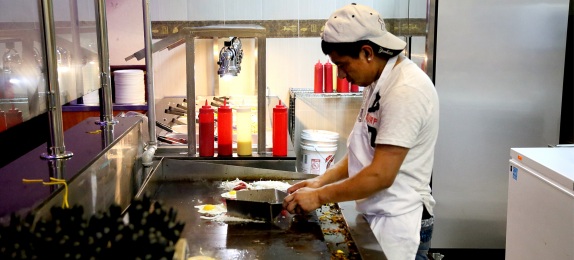
华人企业里的 The "Amigos" in Chinese Businesses
A joint reporting project by AL DIA and Chinese Business Times, looking into the lives of Latino workers in Philadelphia's Chinese-owned businesses.
A joint reporting project by AL DIA and Chinese Business Times, looking into the lives of Latino workers in Philadelphia's Chinese-owned businesses.
In recent years, people from Latin America have become a major force in American immigration. They have also become more and more visible in Chinese-owned restaurants, construction companies and food processing factories.
The mainstream calls them Hispanics or Latinos, while their Chinese employers know them as “Amigos” — friends — in Spanish, which shows how close they are, in spite of the language barrier. In the first of several special reports in which Chinese Business Times has partnered with Al Día, a multi-platform news media organization that showcases the fullness of the Latino experience in the United States, to tell the stories of the Latinos who work in Chinese-owned businesses in Philadelphia.
On a busy morning in Chinatown, José Lemos is quietly sitting outside a business on 11th and Race streets. He is waiting for his shift to start at 10:30 a.m. At the restaurant where he works, he starts his day checking how much of rice available and what items are left from the day before.
“Then I start chopping vegetables and assisting the chef in whatever is needed,” the Honduran immigrant said to Al Día’s reporter, Ana Gamboa. “I have been a restaurant worker for two years. I looked for a job in other parts of the city but couldn’t find any, it was easier to find it in Chinatown.”
Latino workers like Lemos have become more and more visible on the streets of Chinatown. From bussing and prepping in restaurant kitchens to hauling boxes on the streets, Latinos workers are believed — by their Chinese employers — to be wiry but tough. Beyond Chinatown, the working lives of Chinese and Latinos meet in businesses such as construction, food-processing and packaging. But despite the everyday exposure, the two groups have made little progress in understanding each other.
“My employer doesn’t speak much English, and neither do I. I think they should get assistance to communicate better with their workers,” Lemos said.
When Lemos first arrived the United States he looked for a job in New Jersey, but the opportunities were scarce and the pay wasn’t good. He heard of the demand for workers in Chinatown by word of mouth from other Latinos.
He was hired quickly by a Chinese restaurant. Although he didn’t have any prior training, other Latinos who had already worked at the restaurant walked him through the processes step by step.
“I started as a dishwasher, so they didn’t ask me for any experience,” Lemos said. According to him, there are 10 employees in the kitchen. He speaks Spanish with the other Latino workers and through basic signs — or whatever works — with the rest of the team.
“I get along with the other Chinese workers, they are always nice. Now, for the first time ever, I am having Chinese food for lunch everyday,” Lemos said
Not every Latino worker enjoys eating Chinese food, however. According to one of the owners of a destination restaurant in Chinatown (who preferred to remain anonymous), seasoned Latino workers sometimes demand Latino food for lunch, but that is rarely accommodated.
“We sometimes accommodate their needs, and sometimes we don’t,” said the owner. “It really depends on the circumstances.”
Lemos works 12 hours a day, six days a week, earning $750 every two weeks, with one day off chosen by his employers. If he has a concern or needs to skip work, he can talk to the chef and swap his day off.
“But if you miss more than one day, you risk losing your job unless they know you are really sick,” he said. “Although there is no guarantee you will keep your job.”
Lemos has seen the increase of Latino workers in Chinatown, and he believes the restaurants favor them because they work harder and get paid less.
“I like working here. As long as I do my job, everything works out,” he said.
Lemos is married and has eight kids. “I don’t actually cook, but I would like to get a better position to earn more,” he said.
Immigrant to immigrant, an untold story
Chinese business owners often refer their Latino workers as “amigos,” Spanish for friends. In fact, as Chinese Business Times discovered, to the Chinese who do not speak English (or Spanish) well, the words Latino and Hispanic are totally unfamiliar, as are the countries where the Latinos are from.
“We call them ‘amigos,’ and they seem to like that,” said another Chinese restaurant owner, who preferred not be mentioned by name. “No Chinese business owner knows what you are talking about if you mention Latino.”
According to the report “Hispanic Philadelphia: Game Changing Demographics”, published by the Welcoming Center for New Pennsylvanians in 2012, Latinos constitute 187,000 of the city’s 1.565 million residents and report ancestry from more than 20 different countries.
Almost two thirds of Philadelphia Latinos are Puerto Rican, 64 percent of the Latino community. Dominicans and Mexican are each 8 percent of the total community, while Colombians are 3 percent and Cubans 2 percent.
A closer look at the Chinese community reveals similar, yet subtler diversity. The influx of Fujianese immigrants in the 1990s and later, as well as the rising number of Chinese students have changed the face of Chinatown, said Harry Leong, 50, director of the Chinese Christian Church and Center (CCCnC). Leong himself was born and raised in Chinatown.
The diverse Chinese community has a presence in all walks of life. In Northeast Philadelphia, a large number of Fujianese immigrants work as contractors for home construction and decoration. Some run moving companies that charge much lower fees than their competition. In these new enterprises, Latinos have become the desirable helping hands.
At around 6 in every morning (I am not so sure), a group of Latinos gather at the corner of 10th and Arch streets. They are the day laborers (or “jornaleros” as they are known in Spanish) waiting for jobs. For $80, they are willing to test their strength in any kind of work. On an ordinary morning, employers come by every 10 to 15 minutes — the most frequent of all are the scaffold-laden minivans of the Chinese contractors.
“They expend every bit of their strength, do good work and do all kinds of work,” one of the Chinese contractors said. “We usually give them more than $80, and we buy them lunch. They seem to be very happy about it.”
Workers swarmed the contractor’s minivan as he approached that corner the morning Chinese Business Times editor Steve Yuan spoke to him. The contractor nodded at two of the day laborers, who then slid open the door of the van, and got in. The contractor then rolled down the side windows to show the rest of the waiting workers that there was no space left in the car. The workers understood, smiled, waved goodbye and pointed at themselves as if saying “next time, take me.”
Sometimes a group of African-American workers stand at the same corner to compete with the Latinos, only to find that Chinese employers favor the Latinos.
“Maybe it is because Latinos have the reputation for being good workers,” said Sam Garcia, one of the African-American day laborers waiting to be picked for a job. “I wouldn’t blame the Chinese.”
Garcia said he has 50 percent chance of getting a job, while a Latino worker waiting alongside him said he could find a job wherever.
From the Chinese employers’ perspective, there is one recurring concern in hiring Latino workers.
“I think amigos have one issue, which is, they drink too much,” a Fujian-born restaurant owner told Chinese Business Times. He said he noticed that some of his Latino workers spent the nights drinking and skipped work on the next day because they had hangovers. “They disappear without notifying us, which makes us very uncomfortable," he said.
As Chinatown street sweeper Susan Chung told Metro Chinese Weekly (a sister publication of Chinese Business Times) drunk Latinos are easy to spot in Chinatown, laying unresponsively on the street.
Yue Chen, manager of Spring Garden Market in Northern Liberties, said she rarely hired Latino workers for this very reason.
“We had an amigo once. But when he finished working, he went drinking and gambling at Sugarhouse (Casino). The next day he was staggering and his hands were shaking. How could he work like this? We tolerated the behavior several times before we finally fired him.”
According to Javier Garcia Hernandez, who trains Latino workers for PhilaPOSH, a Philadelphia-area workers' advocacy group which focuses on health and safety issues, there are deeper, underlying issues that prompt this behavior.
"The drinking culture could be a reason,” he said, “some Latinos are indeed heavy drinkers. But I think it has something to do with the huge stresses that these immigrants have to face."
Hernandez said there are three stages in a typical Latino immigrant's life: 1) the survival stage, in which the immigrant does whatever job is offered to him or her; 2) the networking stage, in which immigrants form their own social network to get information about what could make their lives better, and 3) the property-owning stage, in which the immigrant has accumulated enough money to settle down.
"Most Latino workers are in the survival stage,” he said. “They face tremendous stress, and some of them feel lost and turn to drink."
Inside the Chinese community, few people have successful experience in understanding the needs of Latino immigrant workers. Leong, the CCCnC director, said he tried to help when a desperate Latino worker approached him for help. But the language barrier made it difficult for them to understand each other.
He sent a request of help to another church known for helping Latino immigrants, but the request went nowhere and Leong suspected the church only helped people with a different country of origin.
"I treated (the Latinos) as part of the Chinatown community. They need our help," he said. "But no one was able to help them."
In the restaurant industry, hope for a better life through education
For Mallory Fix Lopez, program coordinator at the Garces Foundation, there is a growing demand for assistance from the immigrant workers in kitchens across Philadelphia.
Founded in 2012 by Chef Jose and Dr. Beatriz Mirabal Garces, The Garces Foundation is a nonprofit committed to ensuring that Philadelphia’s underserved immigrant community has access to medical, educational, and nutritional services. Fix developed and oversees the program “English for the Restaurant and Everyday Living,” a three-month course that currently has 75 Latino students enrolled.
“It is more than just English classes,” Fix said. “We really want them to have a community and also help them to network in the restaurants.”
The ESOL students meet twice a week and pay $20 dollars a month. The classes focus on English for life, and each lesson refers to the restaurant industry and includes actual demos of a restaurant setting.
“There are many ESOL programs in the city but is hard to find one that really understands the background of the learners, and I feel we do that really well,” Fix said. “Because we focus in such a specific learner we are able to understand who they are, where they come from and what challenges they face.”
“We definitely feel there is a need and a demand for this program,” she said. “Based on the large number of restaurants in Philadelphia, there’s a lot of visibility of Latino workers. This is an industry that is accepting them, and that is easy to get to because it is by word of mouth. The restaurants have generously opened their arms to hire the Latino community.”
According to the Restaurant Opportunities Center United (ROC) in Philadelphia, the restaurant industry is the largest employer of people of color, and the second largest employer of immigrants.
Both groups are disproportionately represented in the industry’s lowest paying jobs. Overall, 58 percent of workers with incomes below the poverty line, and more than 50 percent of tipped workers and restaurant workers with incomes below the poverty line, are people of color.
“The main issues facing our members in Philadelphia are low pay, lack of benefits (such as insurance, paid time off, sick days, etc.) and wage theft,” said the Legal Coordinator for ROC Philadelphia, Sheila Maddali. “Undocumented and documented workers share these experiences, although we do generally see more overtime violations with Latino workers in the back of the house.”
The organization provides restaurant workers with information about their legal rights, free English as a Second language classes they can enroll in, and legal referrals. “We engage workers in policy campaigns, such as efforts to raise the minimum wage and combat wage theft in the local industry,” Maddali added.
The profile of the students helped by the Garces Foundation’s restaurant English program is mixed, Fix said.
“Many of them are single young men who are here by themselves. But we also have families who are here and they are settled but haven’t acquired the language,” Fix said.
She also emphasized the diverse nature of the restaurants for which Latinos are being recruited.
“One of our students works at a Vietnamese restaurant on Washington Avenue, something we would have never guessed,” she said. And we have another student that works at Izumi Restaurant which is a Japanese place in South Philly.”










LEAVE A COMMENT: